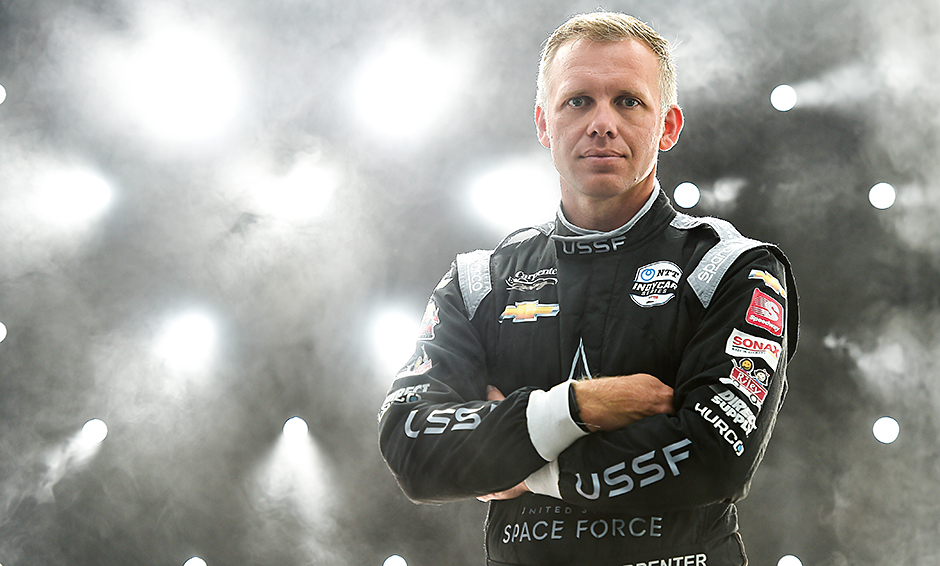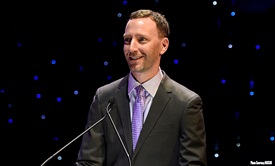Carpenter Hopes To Rocket to Indy 500 Victory with New Backing from U.S. Space Force
AUG 08, 2020
When an NTT INDYCAR SERIES driver has a fast car around the Indianapolis Motor Speedway, it’s often referred to as a “rocket ship.” That will take on a new meaning this year for Indianapolis 500 pole winner Ed Carpenter.
Carpenter’s No. 20 Chevrolet will be sponsored by the U.S. Space Force, the newest branch of the United States Armed Forces.
Early Friday morning on “FOX and Friends,” Carpenter and General Jay Raymond, chief of operations for the U.S. Space Force, announced the exciting new sponsorship that will be part of the 104th Indianapolis 500 presented by Gainbridge, scheduled for Aug. 23.
Carpenter was up early Friday, dressed in his new black racing uniform standing on the porch outside of the Indianapolis Motor Speedway Pagoda. The early-morning sun reflected off the Paddock Penthouse grandstands of IMS.
It glistened like the early morning launches from Cape Canaveral.
That was fitting because Carpenter’s sponsor for the 104th Indianapolis 500 is literally “out of this world.”
“There has been a strong connection between the military and racing for years,” Raymond said. “We are building this new service to be high-tech, light, lean, lethal, fast and built to win, so there is no better partner than Ed Carpenter.”
Two of the three cars from Ed Carpenter Racing are sponsored by a branch of the United States Armed Forces. Conor Daly’s No. 47 Chevrolet is sponsored by the United States Air Force.
“I get excited to hear the general speak like that because that is exactly our focus for the Indianapolis 500 on Aug. 23 to be mean, vicious, fast and lean,” Carpenter explained to the “FOX and Friends” television audience. “We’ve had speed here in the past, and we are super-excited to be representing the U.S. Space Force and hopefully have a great weekend.”
The “Space Age” and the Indianapolis 500 have been joined together for nearly 60 years, beginning when NASA astronauts such as Gordon Cooper started attending the race in 1963. Jim Rathmann, the 1960 Indianapolis 500 winner, owned a Chevrolet dealership in Melbourne, Florida, near Cape Canaveral. Rathmann leased Corvettes to the “Original Seven” astronauts of Project Mercury for $1 a year.
In 1964, astronauts Wally Schirra and Thomas Stafford and America’s first man in space, Alan Shepard, joined Cooper at the Indianapolis 500, including an appearance at the Firestone party.
In 1967, Cooper got to climb into an Indy car and take a few laps around the Indianapolis Motor Speedway.
In 1969 while orbiting the moon, the Apollo 10 astronauts were told by Mission Control in Houston that A.J. Foyt had won the pole for the 1969 Indianapolis 500. When Mission Control told the astronauts Foyt’s pole-winning four-lap average of 170.568 mph, astronaut Stafford was amazed.
“Wow, man, that’s dangerous work, babe,” Apollo 10 commander Gene Cernan radioed back to Mission Control. “That’s too fast.”
Ironically, Apollo 10 holds the record for fastest speed by a crewed vehicle at 24,791 mph on May 26, 1969 during its return from the moon.
“At that speed, we could go around the Indy track in a third of a second,” Stafford said last year.
Other astronauts, including John Glenn, attended the Indianapolis 500 over the years.
In the 1960s, astronauts and INDYCAR drivers captured the American imagination. Sixty years later, technology derived from space exploration and satellites has provided integral parts of the human experience.
“Space fuels our American way of life,” Raymond said. “There isn’t anything we do as Americans or as a joint coalition of force that isn’t enabled by space. Most Americans have used space several times before they watched this show this morning. They have gotten weather reports off of space and information off their smart phones.
“Smart phones are pretty dumb without space.
“Our job in the United States Space Force is to make sure the advantages space provides our nation are always there for Americans and our joint and coalition partners.”
Despite the fact this year’s Indianapolis 500 will be closed to spectators in the grandstands, the U.S. Space Force wanted to showcase this effort to the worldwide television audience, including NBC in the United States.
“This year, because of COVID constraints, there won’t be fans there on the 23rd, and we are disappointed by that,” Raymond said. “But because of the space capabilities that fuel our American way of life, Americans from around the world will be able to watch this, and we are excited to be a part of it.
“I told Ed; we’ve got to win. With a car that looks like that and driven by a driver as professional as Ed Carpenter, I’m pretty confident.”
This is the initial foray into mainstream sports for the U.S. Space Force, and it picked a perfect venue to create awareness for a new mission that protects key communication, weather and surveillance satellites that provide such meaning data to nearly everyone on Earth.
That is what makes the Indianapolis 500 and the U.S. Space Force a perfect fit.
“They were looking for a unique way to spread the word about everything they are doing, and this came together rather quickly,” Carpenter said. “It’s the newest branch, and we want to raise awareness and educate everyone what the purpose of the Space Force is.
“All of our daily lives, we rely on things that happen in space from satellites to GPS to this Zoom call. It’s a competitive environment up there. For the safety of our nation and our allies and our prosperity as a country, what is happening up there is important and it’s important for people to understand that.
“It’s a great tie-in to INDYCAR and what we are about, as well.”



















